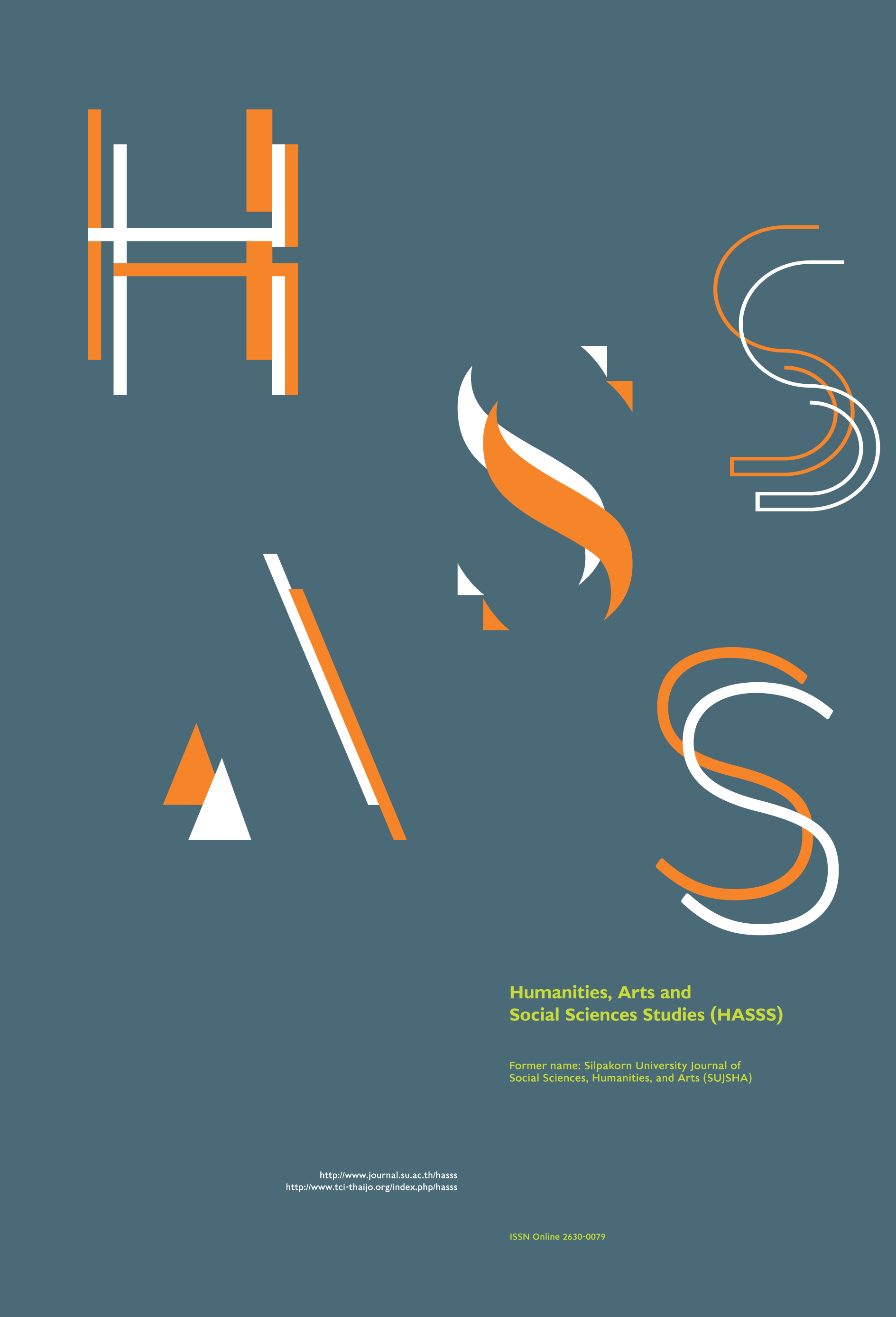The Grammatical Development of Directional Verbs in Black Tai
Main Article Content
Abstract
Certain directional verbs in Black Tai or Tai Dam have developed into many grammatical functions rather than merely verbs, like those in many other languages. This preliminary study aims to explain spatial and temporal meanings in Black Tai directional verbs and to illustrate the grammaticalization path of these verbs. The Black Tai data was collected by interviewing Black Tai native speakers in Thailand and Laos and reviewing Black Tai folklore texts. After that, the elicited data was analyzed along with these three types of theories: grammaticalization, aspectual, and situational.
The common directional verbs in Black Tai are classified into three contrastive pairs: /paj5/ ‘go’ and /ma:4/ ‘come’; /khɯn6/ ‘ascend’ and /loŋ4/ ‘descend’; /khaw6/ ‘enter,’ and /Ɂɔk3/ ‘go out.’ These directional words not only present the movement direction of a subject, but also note some aspectual meanings of a situation by means of the grammaticalization process over time. Spatial and temporal relations increase semantical and syntactic use of the directional verbs more extensively, from verbs to temporal markers. The directional verbs originally function as verbs at the pre-verbal position, and then are grammaticalized to aspect markers at the post-verbal position due to the influence of spatial and temporal relations.
Downloads
Article Details
All rights reserved. Apart from citations for the purposes of research, private study, or criticism and review,no part of this publication may be reproduced, stored or transmitted in any other form without prior written permission by the publisher.
References
Burusphat, S. (2012) Tones of Thai Song Varieties. Journal of the Southeast Asian Linguistics Society (JSEALS) 5: 32-48.
Burusphat, S. (2013) Phonological Variation and Change in Thai Song. Research Project Ethnicity: New paradigm in language and cultural transmission. Mahidol University: Nakorn Prathom.
Bybee, J. L., Perkins, R. D., & Pagliuca, W. (1994) The Evolution of Grammar: Tense, Aspect, and Modality in the Languages of the World. Chicago: The University of Chicago Press.
Bybee, J. L. (2011) Usage-based theory and grammaticalization. In Heine, B. and Narrog, H (Eds.). The Oxford Handbook of Grammaticalization, pp. 69-78. Oxford: Oxford University Press.
Bybee, J. L. (2015) Language Change. Cambridge: Cambridge University Press.
Comrie, B. (1976) Aspect: An Introduction to the Study of Verbal Aspect and Related Problems. Cambridge: Cambridge University Press.
Dechapratumwan, P. (2016) A Code-switching in Casual Conversations: A Case Study in Tai Dam Bilinguals at Baan Huathanoon of Nakhonpathom, Thailand. Ph.D. dissertation, Mahidol University.
Edwards, T. A. (2011) Participant Reference in Tai Dam Narrative Discourse. M.A. thesis, Payap University.
Enfield, N. J. (2007) A grammar of Lao. Berlin: Mouton de Gruyter.
Gedney, W. (1964) A comparative sketch of White, Black and Red Tai. The Social Science Review Special number 14: 1-47.
Givon, T. (1973) The time-axis phenomenon. Language 49: 890-925.
Heine, B. (2003) Grammaticalization. In The Handbook of Historical Linguistics, edited by B.D. Joseph and R.D. Janda, pp. 575-601. Oxford: Blackwell Publishing.
Hopper, P. J. and Traugott, E. C. (1993) Grammaticalization. Cambridge: Cambridge University Press.
Intratat, C. (1996) Grammaticalization of Verbs into Prepositions in Thai. Ph.D. dissertation, Chulalongkorn Univeresity.
Iwasaki, S. and Ingkaphirom, P. (2005) A Reference Grammar of Thai. Cambridge: Cambridge University Press.
Lakeoff, G. and Johnson, M. (2003) Metaphor We live By. London: The University of Chicago Press.
Lehmann, C. (2002) Thoughts on Grammaticalization. Arbeitspapiere des Seminars für Sprachwissenschaft der Universität Erfurt.
Li, F. K. (1960) A tentative classifications of Tai Dialects. In Culture in history essay in honor of Paul Radin, edited by Stanley Diamond, pp. 951-959. New York: Colombia University Press.
Matisoff, J. A. (1991) 'Areal and Universal Dimensions of Grammatization in Lahu.' In E. C. Traugott and B. Heine, Eds. Approaches to Grammaticalization, I: Focus on Theoretical and Methodological Issues. Amsterdam, John Benjamins 383-453.
Meillet, A. (1912) L’evolution des forms grammaticales. Scientia (Reivista di Scienza). 12(23) 6. Reprint: Millet 1921: 130-148.
Rangkupan, S. (1992) Subsidiary Verbs Pay1 ‘Go’ and Maa1 ‘Come’ in Thai. M.A. thesis, Mahidol University.
Sindhvananda, K. (1970) The Verb in Modern Thai. Ph.D. dissertation, Georgetown University, Washington D.C.
Thepkanjana, K. (1986) Serial Verb Constructions in Thai. Ph.D. dissertation, The University of Michigan, USA.
Thepkanjana, K. and Uehara, S. (2008) Directional verbs as success markers in Thai: another grammaticalization path. In A.V. N. Diller, J. A. Edmonson, and Y. Luo (Eds.). The Tai-Kadai Languages, pp. 484-505. London/New York: Routledge.
Thiengburanathum, P. (2010) Linguistic Encoding of Events in Thai. Ph.D. dissertation, La Trobe University.
Thiengburanathum, P. (2010) Linguistic Encoding of Events in Thai. Ph.D. dissertation, La Trobe University, Australia.
Van Valin, R. D. (2005) Exploring the Syntax-Semantics Interface. Cambridge: Cambridge University Press.


